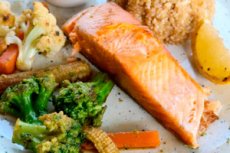Antioxidants fight female reproductive problems caused by high-fat diets
最近審查:14.06.2024

In a systematic review published in Frontiers in Nutrition, researchers from Italy provided a comprehensive overview of the effects of biological matrices with antioxidant properties on mitigating high-fat diet-induced complications of the female reproductive system.
High-calorie diets, including those rich in saturated and trans fats, can negatively impact the female reproductive system by causing the production of reactive oxygen species (ROS) and, consequently, inducing oxidative stress. This can lead to irregular ovulatory cycles and premature ovarian failure.
Diet-induced ROS production can affect the blood supply to the reproductive organs and disrupt the hypothalamic-pituitary-ovarian axis. These processes can cause hormonal imbalances, induce insulin resistance and hyperleptinemia, promote chronic low-grade inflammation, affect oocyte quality, and impair embryo implantation in the uterus and maintenance of pregnancy.
Biological matrices that can positively affect the female reproductive system include carbocyclic sugars, phytonutrients, organosulfur compounds, hormones, neuropeptides, organic acids, and vitamins. These matrices mainly contain a variety of antioxidants that help reduce ROS-induced oxidative damage.
In this systematic review, the authors evaluated the efficacy of biological matrices in preventing ovarian complications caused by high-fat diet-induced oxidative stress. They analyzed 121 studies published in peer-reviewed English-language journals.
Antioxidants derived from biological matrices and their effect on oxidative stress induced by a high-fat diet
Folliculogenesis is the process of maturation of primordial germ cells into oocytes within follicles, which is vital for the optimal functioning of the female reproductive system.
A high-fat diet can cause oxidative damage to the ovaries by specifically affecting follicle development, follicle survival, and the production of hormones required to regulate folliculogenesis. These factors can affect oocyte quality and disrupt embryo development.
In rodent models of high-fat diet-induced oxidative stress, a diet containing a combination of two phytonutrients, barley and dates, preserved ovarian follicles, increased their development and proliferation, restored ovarian stroma, and increased levels of endogenous enzymatic antioxidants.
These positive results may be explained by the increase in flavonoid activity and phenolic antioxidant properties contained in ferulic acid, kaempferol, malvidin, caffeic acid and quercetin derivatives.
In mouse models of high-fat diet-induced oxidative stress, a diet containing thymoquinone activated the AMPK/PGC1α/SIRT1 pathway, increasing antioxidant status, reducing inflammation, and improving mitochondrial function. These changes are associated with an increase in the number of follicles in the early stages and an improvement in the quality of oocytes.
A diet containing the neuropeptide phoenixin reduced ovarian weight, reduced periovarial fat pads, modulated luteinizing hormone (LH) receptor positivity in rodents, and reduced ovarian apoptosis and inflammation in rodents exposed to a high-fat diet.
In obese rats, a multi-antioxidant supplement including organosulfur compound, phytonutrients, vitamin E and coenzyme Q10 reduced ovarian inflammation and follicular atresia, and alleviated obesity-induced infertility.
In rats exposed to a high-fat diet, a diet containing apple cider vinegar and phoenixin restored hormonal balance, increased folliculogenesis, and improved the antioxidant response in the ovaries.
A diet containing ferulic acid, kaempferol, malvidin, caffeic acid and quercetin derivatives increased the levels of both enzymatic and non-enzymatic antioxidants in rats exposed to a high-fat diet, resulting in oocyte protection from DNA damage. p>
Similarly, MitoQ10 supplementation was able to reduce oxidative stress caused by a high-fat diet and improve mitochondrial function, mitigate DNA damage, and maintain oocyte quality.
Organosulfur compounds have shown effectiveness in alleviating infertility caused by high-fat diet-induced obesity. Dietary interventions containing ferulic acid, kaempferol, malvidin, caffeic acid and quercetin derivatives, as well as the combined use of myo-inositol and α-lipoic acid, have been shown to be effective in protecting against ovarian cycle disorders and reducing ovarian degenerative changes caused by oxidative stress. p>
Overall, existing literature indicates that biological matrices as antioxidants can effectively reduce the number of atretic follicles, inflammation, and ovarian apoptosis. This is supported by decreased ovarian weight, decreased periovarial fat pads, and modulation of LH receptor positivity.
Clinical significance of biological matrices as antioxidants
Assisted reproductive technologies are considered a traditional method of treating infertility. However, this method cannot effectively address the underlying causes of infertility associated with a high-fat diet. Biological matrices as antioxidants have shown promising results in the treatment of these problems.
Omega-3 fatty acids and vitamin B12 have been shown to be effective in reducing symptoms of endometriosis, a hormone-related chronic inflammatory disease that affects women of reproductive age.
Results from randomized controlled clinical trials highlight the effectiveness of vitamins E and C in reducing pelvic pain and inflammatory markers in peritoneal fluid.
Biological matrices including vitamin A, vitamin B1, vitamin B6, vitamin B12, vitamin C, vitamin D3, vitamin E, niacinamide and folic acid have been shown to be effective in improving pregnancy rates in women with polycystic ovary syndrome (PCOS).
Resveratrol treatment in patients with PCOS has shown improvement in the quality of oocytes and embryos. Likewise, treatment with vitamins D and E has been shown to increase implantation rates and overall pregnancy success, respectively.

